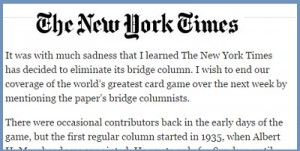 The cessation of this column is a sorrowful event for those who love bridge and reading newspapers, but nothing else can be done than remembering what it was.
The cessation of this column is a sorrowful event for those who love bridge and reading newspapers, but nothing else can be done than remembering what it was.
The first known indirect reference to whist happened in a church: it was on Christmas 1529 when the bishop Hugh Latimer delivered at Oxford the so called Sermon on Cards, in which he first quoted a game, called “trump”, which had to be very similar to whist, if not a synonym. Latimer used the game as a metaphor: the power of trump over other suits like the power of the Christ’s word that wins over anything else into the human being’s heart.
The New York Times was established later, in 1851, but soon grew, and soon the newspaper and the great game met, making a fixed partnership since 1935. The relationship between them became synergic in a way that resembles what sometimes happens between a great theatre and its main performer: Metropolitan or La Scala, for example, and Enrico Caruso, Carla Fracci, Maria Callas; neither the performer nor the theatre needs one another to be great, but, together, both become greater and greater.
Let us see an example of this in bridge. Two years ago I published in Neapolitan Club an article about a very aggressive American pair; their opening could be as weak as by ♠AQxx ♥Axxx ♦xx ♣xxx. But I also wrote:
“Speaking of aggressiveness, in general, it is deemed a modern feature; but this is true only if compared with the bridge of the fifties and sixties; but if we take a glance to the twenties, a century ago, our bidding style appears boarding school girl stuff. Overcall and jump shift response by zero points were the rule, and about the one level, look here:
♠AKxxx ♥xxx ♦xx ♣xxx
Open it 1♠, advised in 1916 Florence Irwin, leading author and columnist of New York Times”
Florence Irwin was a great theorist who wrote several books; she’s little known because the Auction Bridge, the game she wrote about, vanished in the late twenties. In the above article I had to explain to the today’s reader who she was and why her opinion mattered so much; I made all this by just five words: Columnist of New York Times.
Who thinks that the column should survive can write to the Public Editor, Margaret Sullivan, at public@nytimes.com, or to Letters to Editor at letters@nytimes.com.
***
Paolo Enrico Garrisi